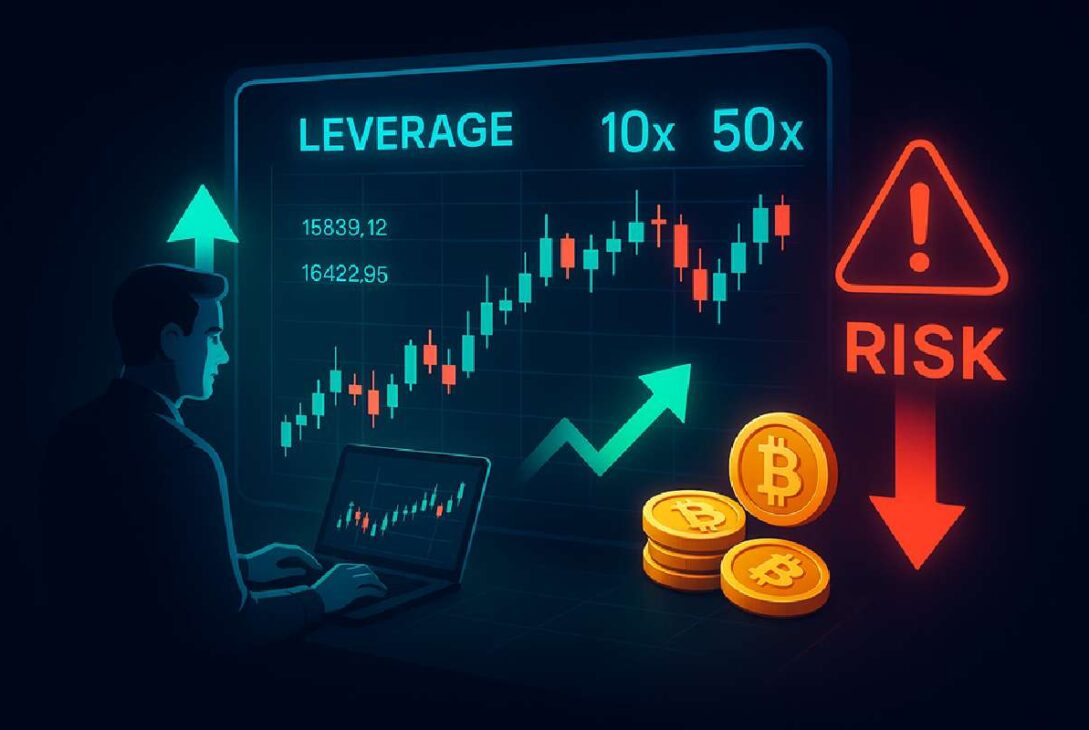Crypto leverage trading has become increasingly popular among both retail and institutional traders. It allows market participants to open larger positions with a relatively small amount of capital, offering the potential for amplified gains. However, with increased reward comes increased risk. Understanding how leverage works, its benefits, and the associated dangers is essential for anyone considering this advanced trading strategy.
This guide provides an in-depth look at the mechanics of leverage trading in cryptocurrency markets, outlines its risks and rewards, and presents strategies for managing exposure. It is intended for educational purposes only and should not be construed as financial or investment advice.
What Is Crypto Leverage Trading?
Crypto leverage trading involves borrowing funds to increase the size of a trading position. Traders commit an initial deposit, known as margin, which serves as collateral. The platform lends additional capital based on the leverage ratio selected, such as 2x, 5x, or even up to 100x.
For example, using 10x leverage allows a trader to control a $10,000 position with just $1,000 in margin. While this can significantly increase profit potential, it also amplifies losses. The borrowed funds must be repaid regardless of trade outcome, and if the market moves against the position, the margin may be liquidated.
How Does Leverage Trading Work in Practice?
Leverage trading typically occurs in the derivatives market through instruments such as perpetual futures or margin contracts. These allow traders to speculate on price movements without owning the underlying asset.
When opening a leveraged position, traders choose between two primary directions:
- Long position: Profits if the asset price increases.
- Short position: Profits if the asset price decreases.
Platforms like MEXC offer both USDT-margined and coin-margined contracts, allowing flexible leverage and margin management. Traders can also select between isolated margin (risk confined to one position) or cross margin (margin shared across positions). Popular pairs such as SUIUSDT illustrate how new assets can quickly gain traction in leveraged markets, providing opportunities for both long and short strategies.
Each trade has a liquidation price. If the market moves against the position and the margin falls below the required maintenance level, the platform may automatically close the trade to prevent further losses.
The Rewards: Why Traders Use Leverage
Leverage trading provides several potential benefits, particularly for experienced traders who manage risk effectively.
1. Amplified Profit Potential
By using leverage, traders can control larger positions than their capital alone would allow. Even small market movements can result in significant gains when leverage is applied correctly. For example, a slight increase in the ETH USDT pair can deliver outsized returns under leveraged conditions, making it one of the most commonly traded assets on futures platforms.
2. Capital Efficiency
Leverage allows efficient use of trading capital. Rather than tying up large sums to gain exposure, traders can allocate funds across multiple positions or strategies.
3. Access to Both Market Directions
Leverage trading supports both long and short positions. This enables traders to profit in bull or bear markets, increasing flexibility in various market conditions.
4. Advanced Strategies
Leverage is essential for implementing complex strategies such as hedging, arbitrage, and high-frequency trading. These strategies are often used in professional or algorithmic environments.
The Risks: What Makes Leverage Dangerous?
Despite its advantages, leverage trading introduces substantial risks. Without proper risk management, losses can exceed the initial investment.
1. Magnified Losses
Just as leverage can amplify gains, it also magnifies losses. A 10 percent unfavorable move with 10x leverage results in a complete loss of the initial margin.
2. Liquidation Risk
If the value of a leveraged position drops to a specific point, the platform may liquidate it to prevent further loss. This results in the forfeiture of the margin and potentially additional fees.
3. Volatility Sensitivity
Cryptocurrency markets are known for their volatility. Sudden price swings can trigger margin calls or automatic liquidation even if the overall trend favors the trade.
4. Psychological Stress
Managing leveraged trades requires discipline and emotional control. The potential for rapid losses can lead to panic decisions or overtrading.
5. Additional Costs
Leveraged positions often incur funding fees, interest charges, and higher trading fees. These can erode profits, especially for trades held over long periods.
Real-World Examples of Leverage Gone Wrong
Historical market events illustrate how high leverage can exacerbate losses:
- March 2020 (COVID-19 crash): Bitcoin’s price fell by over 40 percent in a single day, leading to mass liquidations across exchanges.
- May 2021 (Bitcoin correction): A sharp 30 percent drop caused billions in leveraged positions to be wiped out within hours.
These examples highlight the importance of prudent leverage use and risk controls.
Risk Management Strategies
To trade leverage responsibly, risk mitigation strategies are essential.
Start with Low Leverage
Begin with conservative ratios such as 2x to 5x, especially when learning. Higher leverage should be reserved for advanced strategies and experienced traders.
Use Stop-Loss and Take-Profit Orders
Automated exit orders help manage downside risk and lock in profits. Set clear parameters before entering any trade.
Understand Liquidation Prices
Know where your position will be liquidated and monitor it closely. Use available tools to track your exposure in real time.
Choose Margin Modes Wisely
Isolated margin limits risk to a single trade, while cross margin shares funds across positions. Choose based on your strategy and risk tolerance.
Avoid Averaging Down
Adding to losing positions may increase risk. If the trade setup is invalidated, it is often safer to exit and reassess.
Practice With Demo Accounts
Many platforms, including MEXC, offer demo trading environments. Use these to test strategies without risking real funds.
Getting Started With Leverage Trading on MEXC
Before using leverage, traders should ensure they understand platform mechanics, margin requirements, and fee structures. MEXC provides access to both USDT-margined and coin-margined futures, with flexible leverage options up to 500x on select pairs.
The platform supports both isolated and cross margin modes, real-time risk indicators, and price alerts. For those new to leverage trading, demo accounts and educational resources can provide a safe starting point.
New users should begin with small positions, carefully monitor liquidation thresholds, and gradually increase complexity as their understanding improves.
Ready to explore leverage trading? Discover MEXC, a secure, low-fee platform with deep liquidity and a full range of futures contracts. Start trading responsibly today.
Conclusion: Is Leverage Right for You?
Leverage trading in crypto can offer significant upside, but it comes with serious risks. It is not suitable for all traders and should only be approached with a well-developed strategy and strong risk discipline.
Amplified gains are appealing, but the possibility of rapid liquidation and capital loss must be acknowledged. Successful leverage traders prioritize education, discipline, and ongoing strategy refinement.
This article is for informational purposes only. It does not constitute financial advice. Readers should consult a qualified financial advisor before making investment decisions.



